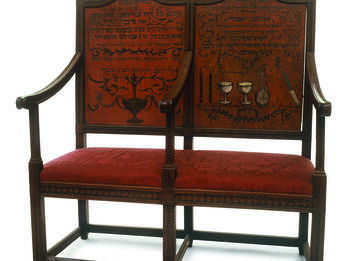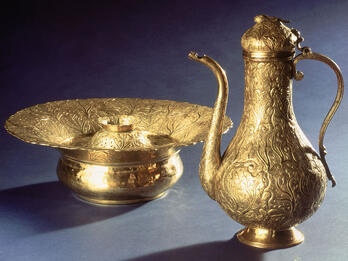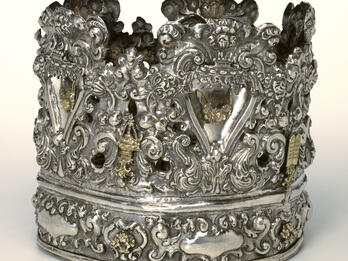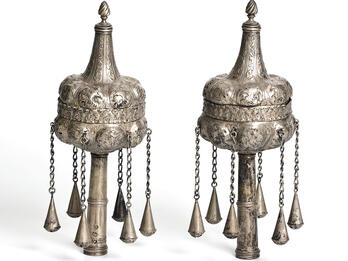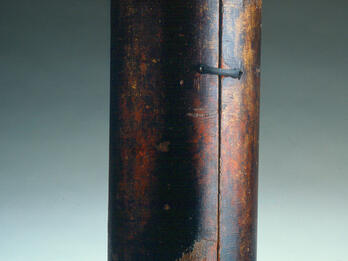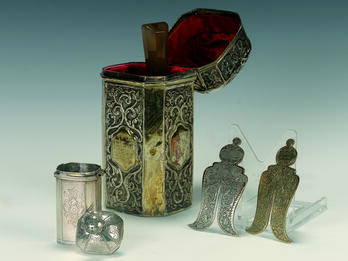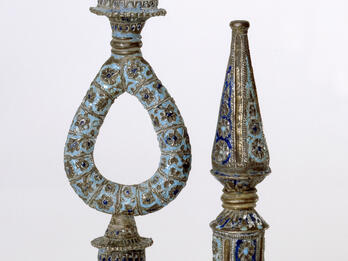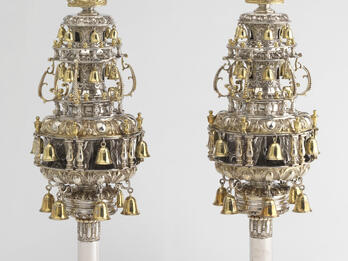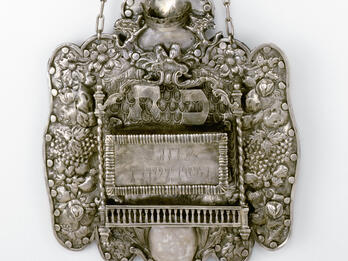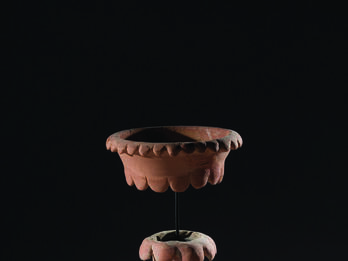Showing Results 1 - 10 of 43
Restricted
Image
In Ashkenazic communities, circumcision benches with two seats were sometimes used from the nineteenth century on, one for the sandek, the godfather on whose lap the baby boy is circumcised, and one…
Contributor:
Artist Unknown
Places:
Eidlitz, Holy Roman Empire (Údlice, Czech Republic)
Date:
ca. 1805
Subjects:
Categories:
Restricted
Image
This ewer and basin from Turkey were used to wash hands ritually during the Passover seder. Owned by the Benguiat family, a large and prominent Sephardic family in the Ottoman Empire, the objects…
Contributor:
Artist Unknown
Places:
Constantinople, Ottoman Empire (Istanbul, Turkey)
Date:
ca. 1845
Subjects:
Categories:
Restricted
Image
This silver Torah crown from Padua, Italy, is decorated with images of the tablets of law, incense utensils, the ark of the covenant,
and the headdress of the high priest.
Contributor:
Artist Unknown
Places:
Padua, Venice (Padua, Italy)
Date:
17th–18th Century
Subjects:
Categories:
Restricted
Image
These silver Torah finials are from Corfu and were made between the seventeenth and eighteenth centuries, by an artist whose initials were A.Z. They were used in the Scuola Greca Synagogue, which…
Contributor:
A.Z.
Places:
Kérkyra (Corfu), Ottoman Empire (Corfu, Greece)
Date:
Late 17th–Early 18th Century
Subjects:
Categories:
Restricted
Image
This lacquered, cylindrical case for a Torah scroll was made from a combination of wood, bronze, and iron in Kaifeng, China. (The hard-sided Torah case was a Sephardic tradition. It offered more…
Contributor:
Artist Unknown
Places:
Kaifeng, Qing Dynasty (Kaifeng, China)
Date:
17th or 18th Century
Subjects:
Categories:
Restricted
Image
This silver circumcision set was crafted in Salonika in the Ottoman Empire. The cylindrical silver casket holds a circumcision knife; its handle is made from agate. A similarly shaped powder box and…
Contributor:
Artist Unknown
Places:
Salonika, Ottoman Empire (Thessaloniki, Greece)
Date:
18th Century
Subjects:
Categories:
Restricted
Image
These small Torah finials, decorated with silver repoussé and dark and light blue enamel, originated in Persia. They are further adorned with slender flowers and graceful geometric patterns.
Contributor:
Artist Unknown
Places:
Ottoman Empire (Iran)
Date:
18th Century
Subjects:
Categories:
Restricted
Image
These richly decorated Torah finials (rimonim), cast in silver and partly gilt, and adorned with many bells and topped with crowns, were created in London. The non-Jewish silversmith William Spackman…
Contributor:
William Spackman
Places:
London, Great Britain (London, United Kingdom)
Date:
1719
Subjects:
Categories:
Restricted
Image
This silver, repoussé, punched, engraved, and cast Torah shield, decorated with flowers and bunches of grapes, from Metz, France, is inscribed in Hebrew: C[rown of] T[orah]; Festival of Shavuot.
Contributor:
Artist Unknown
Places:
Metz, France
Date:
17th–18th Century
Subjects:
Categories:
Restricted
Image
The chalice, covered with red slip (a thin mixture of red clay and water), consists of a tall, hollow stand and a separate bowl; both parts are decorated with downturned petals. Together they stand…
Places:
Arad, Land of Israel (Tel ‘Arad, Israel)
Date:
Iron Age IIA (?)–IIB, 9th (?)–8th Century BCE


